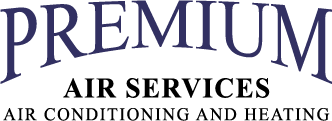
Ceiling fans are one of the most overlooked ways to enhance comfort and reduce energy costs. By boosting air circulation and supporting your HVAC system, ceiling fans and energy efficiency are truly a match made in heaven. They offer a smart, energy-efficient way to keep cool while easing strain on your AC—helping you avoid unnecessary air conditioning repair.
In this blog, the experts at Premium Air Services LLC discuss how ceiling fans can keep you cool while increasing your HVAC efficiency. We'll also share some HVAC efficiency tips that make the most of ceiling fans.
Comfort vs. Temperature: The Effect of the Wind-Chill Effect Indoors
Ceiling fans don’t actually lower the room temperature—they make your home more comfortable by blowing air across your skin. This is known as the wind-chill effect, and it can make a room feel up to 4 degrees cooler without touching the thermostat. That means you feel less hot and enjoy the benefits of indoor air circulation from your ceiling fan while minimizing air conditioner use—helping reduce your electric bill in summer.
The Best of Both: Why You Should Use Fans and Air Conditioning Together
There are several advantages to using ceiling fans and air conditioning in tandem, especially on hotter days. By combining both, you increase HVAC efficiency and maintain a comfortable indoor temperature with less strain from your cooling system.
Benefits of using ceiling fans and AC together:
- Ceiling fans help lower HVAC load by moving cool air more evenly throughout a room. Limiting HVAC stress is important, because it can prevent a breakdown that may result in premature AC or furnace installation.
- Using ceiling fans enhances comfort by reducing uneven temperatures and improving air movement.
- Combining ceiling fans and AC can reduce overall energy use. If you have a home automation system, you can even modify your smart thermostat settings to bump up the temp a few degrees while your ceiling fan is running.
Clockwise vs. Counterclockwise Ceiling Fan Rotation: What Direction to Spin in Summer and Winter?
To maximize the benefits of your ceiling fans year-round, it’s important to ensure blades are rotating in the right direction for the season. The direction impacts how air moves, which can either make you feel cooler or gently recirculate warm air so you feel warmer.
When it's best to spin ceiling fans counterclockwise
When it's hot outside, ceiling fans should turn counterclockwise at a faster setting. This creates a breeze that pushes cool air downward, amplifying the wind-chill effect and creating a cooler sensation.
When to rotate ceiling fans clockwise
On cold days, set your fan to turn clockwise on a gentle setting. This lifts cooler air and circulates heated air down to where you can feel it, making the space feel cozier without changing your thermostat.
Things to Look for in a Ceiling Fan
Picking the best ceiling fan depends on a few important details, such as blade design, airflow rating and room dimensions. First, look for fans that offer a good combination of ECFM airflow and blade pitch to ensure efficient air movement in your home:
- ECFM refers to the amount of air a fan circulates—the cubic feet per minute, or CFM—per watt of electricity used. Fans with greater ECFM are the most energy efficient.
- Blade pitch refers to the angle of the blades. A steeper blade pitch moves more air than a shallower pitch but can also strain the motor.
Also, consider room size when sizing a ceiling fan—a fan that’s too small won’t move as much air as you'd like, while one that’s too big may be too strong for the space.
Boost Your HVAC Efficiency With Help from Premium Air Services LLC
At Premium Air Services LLC, our HVAC specialists can help you enjoy year-round comfort while reducing strain on your heating and cooling systems. From efficient ceiling fan strategies and air conditioning installation to smart thermostats and furnace repair, we offer comprehensive services that work with your budget. Set up your appointment by calling 713-364-1078 today.
